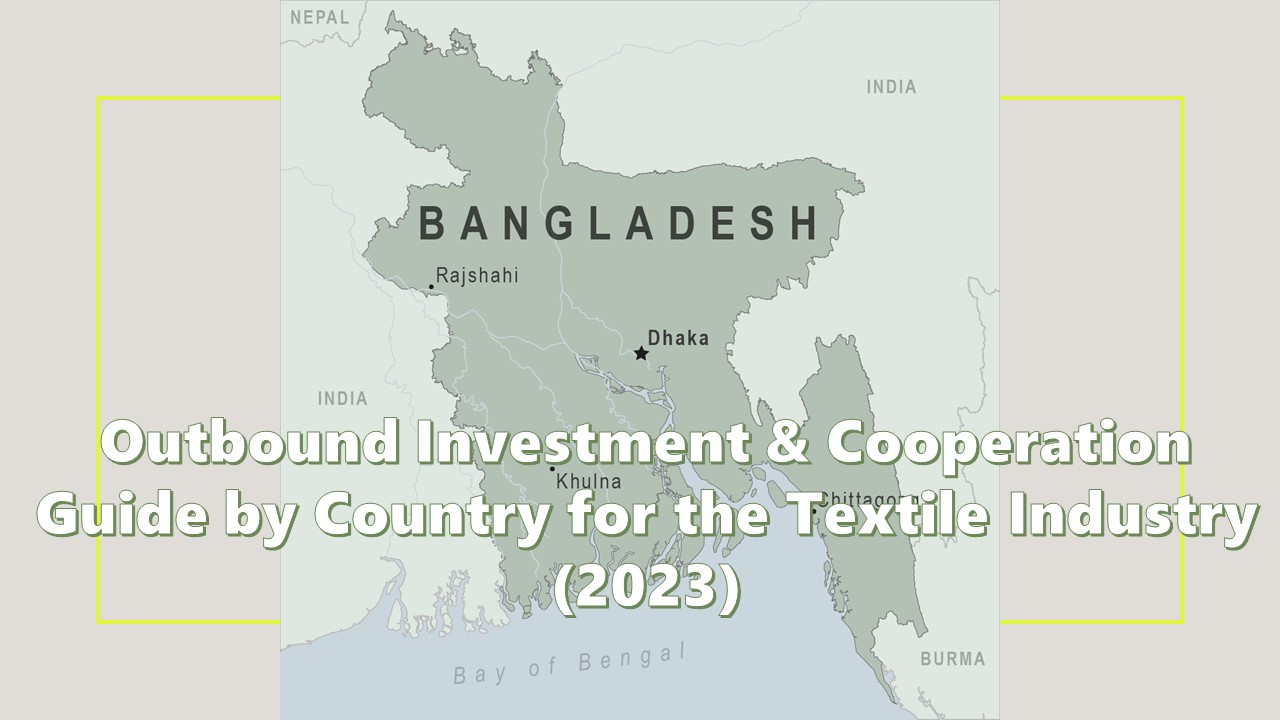2024/2/22

On November 3, 2023, the Marketing Department of China National Textile and Apparel Council (CNTAC), and the Sub-Council of Textile Industry, China Council for the Promotion of International Trade (CCPIT TEX) jointly released the Outbound Investment and Cooperation Guide by Country for the Textile Industry (2023) at the 6th Belt and Road Textile Conference. This report introduces and analyzes the investment environment of 20 countries around the world. It provides information and guidance for textile enterprises to engage in “Belt and Road” cooperation.
South Asia - Bangladesh
Geography: located in the South Asian subcontinent, Bangladesh is a hub connecting the three major economies: China, India, and ASEAN. Bordering India to the east, west, and north, Myanmar to the southeast, and the Bay of Bengal to the south, Bangladesh has a 580-kilometer-long coastline, with 79% of its territory being flat plains.
Natural Resources: Bangladesh has limited mineral resources. Natural gas is the primary energy source, constituting 55% of the total energy mix, with confirmed reserves of 311.39 billion cubic meters. And coal reserves total about 750 million tons.
Macroeconomy: Bangladesh is classified by the United Nations as one of the Least Developed Countries (LDCs), with a Gross Domestic Product (GDP) of US$ 460.2 billion in the fiscal year 2021/2022 (July 1, 2021-June 30, 2022), and a per capita GDP of US$ 2,793. From the industrial structure, the value added of the primary sector accounts for about 12% of GDP; that of the secondary sector, about 35%; and the tertiary sector, about 53%. From a demand perspective, consumption accounts for 75% of GDP and is the major driver of economic growth. The World Bank’s Doing Business 2020 report reveals that Bangladesh holds the 168th position out of 190 participating countries and territories.
Status of Textile Industry
The industrial value added of the textile and garment industry, one of the pillar industries of Bangladesh, accounts for about 13% of the country’s GDP; its exports account for about 80% of the total. Among them, apparel, jute, and related products are the main industries and export commodities of the textile industry. There are about 5,000 garment processing enterprises in Bangladesh, employing nearly 5 million people, of which more than 80% are women. The business model of garment enterprises mainly relies on exporting OEM, and numerous European and American apparel brands have set up a procurement supply chain in Bangladesh.
Bangladesh is a big importer of cotton, importing about 1.8 million tons of cotton every year for downstream yarn and fabric production. However, the textile industry supply chain is not perfect. The scale of spinning, weaving, dyeing, and finishing, among other aspects, is not large, and its development is relatively slow. Fabrics are highly dependent on imports. Besides that, Bangladesh is the world's second-largest producer of jute, with an annual output of over 1 million tons.
International Trade
Bangladesh's textile industry exports are dominated by apparel, which is the world's second largest apparel exporter after China; while imports are dominated by fabrics. According to the Bangladesh Bureau of Statistics, in 2021, Bangladesh’s textile and apparel exports amounted to US$ 38.96 billion. The main export markets are the United States, Germany, the United Kingdom, and Spain, of which the United States accounted for 20% of the total exports, and Germany accounted for 16%. The main export products are apparel, accounting for 96% of the total textiles and apparel exports, of which knitted garment exports accounted for 53%. During the same period, textile and garment imports amounted to US$ 19.43 billion. China is the largest importer of Bangladesh, accounting for about 38% of the total imports, followed by India and Hong Kong, China. Various types of yarn and fabric imports accounted for about 89.4% of textile and garment imports, the main imports of cotton, cotton yarn and cotton woven fabrics (accounting for 54.1%), chemical fiber filament and fabrics (accounting for 13.1%), knitted fabrics and crochet fabrics (accounting for 11.5%), and chemical fiber staple and fabrics (accounting for 10.7%).
Industry Layout
Bangladesh’s garment factories are primarily concentrated in Dhaka, the capital, and Chittagong, the largest port city. These areas have relatively good infrastructure and transportation facilities and are home to the two largest and earliest established export processing zones.
Summary and suggestion for investment
(1) Bangladeshi products enjoy zero-tariff preferential policies in the European Union, Japan, Canada and other markets. Bangladesh boasts rich labor resources and low costs.
(2) The Bangladeshi government encourages foreign investment in the linen textile industry, garment industry and home textile industry. The fields above can be considered potential investment fields. However, due to the gap in power supply and the incomplete textile industry supply chain, it is advisable for enterprises to carefully consider the future factory infrastructure and the supply of raw and auxiliary materials.
(3) Bangladesh has strict foreign exchange control, and workers’ strikes happen occasionally. The world’s least developed countries enjoy tariff reductions and exemptions, but these benefits may be canceled as part of their economic development. This poses risks in the process of investment cooperation.
Source: CHINA TEXTILE LEADER Express



Authority in Charge: China National Textile and Apparel Council (CNTAC)
Sponsor: China Textile Information Center (CTIC)
ISSN 1003-3025 CN11-1714/TS
© 2025 China Textile Leader, all rights reserved.
Powered by SeekRay